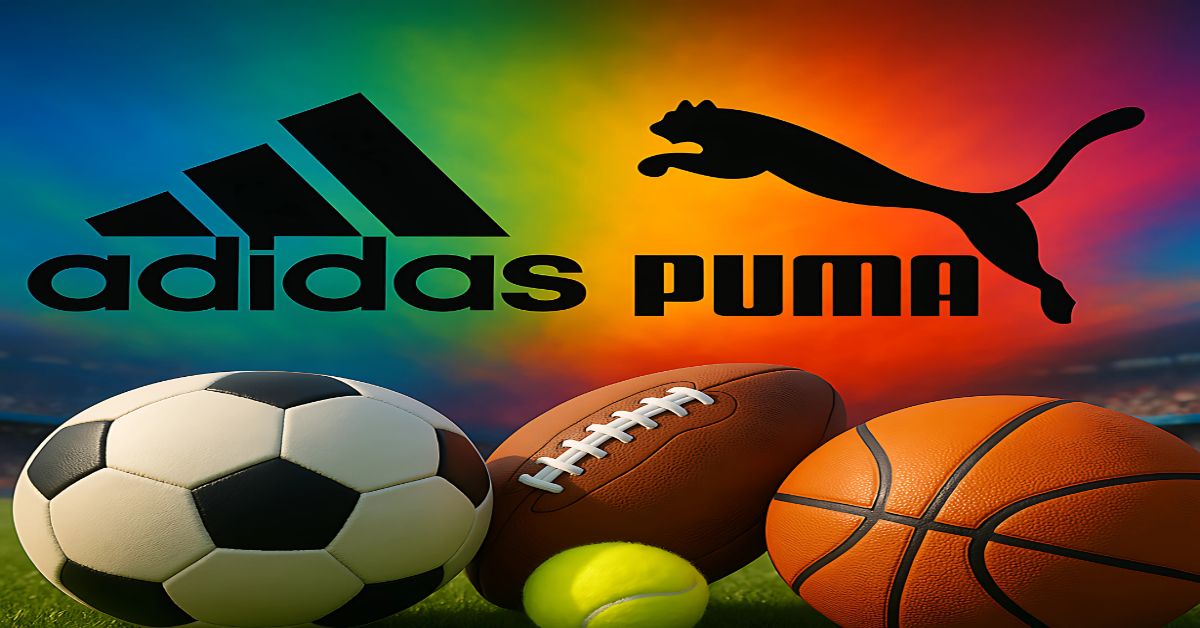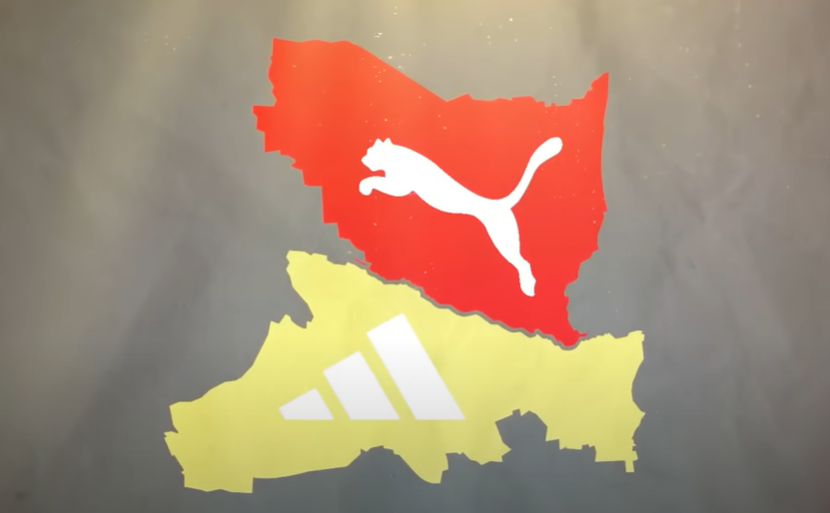Alright, tell me this how do we make friends? Through people’s behavior, speech, and mentality, right? But what if the only criteria for friendship or enmity were the shoes on someone’s feet? As strange as it sounds, that was the reality of a town in this world! People would first look at your shoes to decide if you were a friend or an enemy. If an outsider’s shoes didn’t match their preferred brand, they wouldn’t even bother talking to them!
This created a strange rivalry among people, and the two shoe brands behind it were none other than Adidas and Puma. But this is not just a story of Adidas and Puma. It’s a story of two brothers’ rivalry, betrayal, and making history! Today, we’ll uncover how the enmity between two brothers gave birth to two globally renowned brands – Adidas and Puma!
The Story of Two Brothers
In the 1920s, a small town in Germany, Herzogenaurach. Adolf (Adi) Dassler and Rudolf Dassler were born into a humble family in this town. Adi, the younger brother, was quiet but skilled in shoe design and technology. Rudolf, the elder brother, was sharp and business-minded. Their father was an ordinary shoemaker. But Adi and Rudolf wanted to do something big.
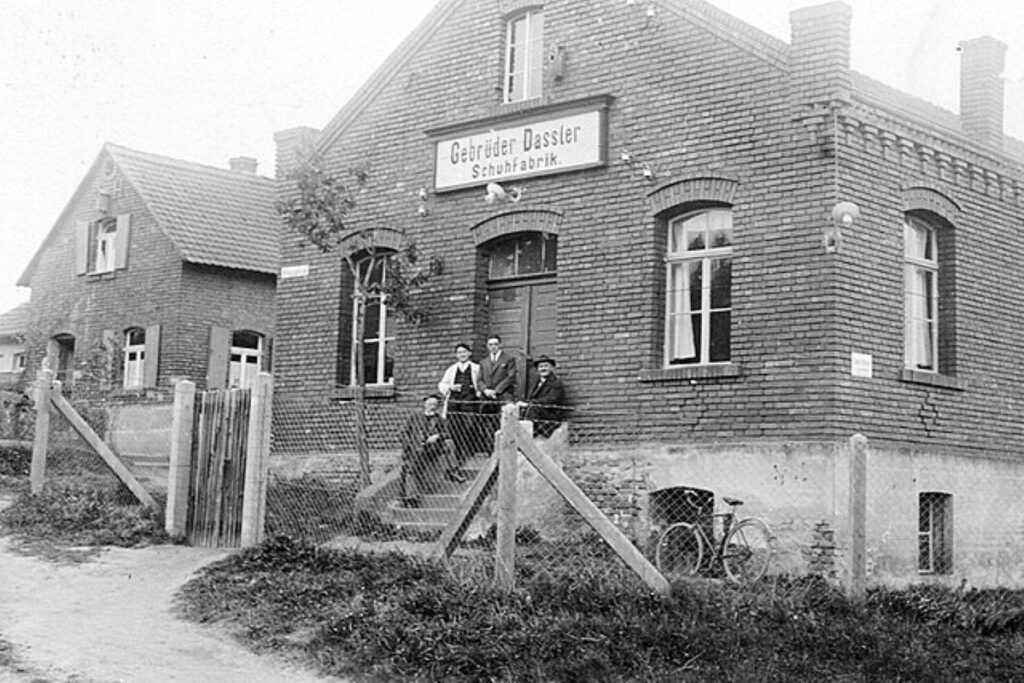
In 1924, they launched a shoe company called Gebrüder Dassler Schuhfabrik, which quickly became popular for making athletic shoes.During the 1936 Berlin Olympics, American legend Jesse Owens won four gold medals wearing spikes made by the Dassler Brothers! This was a huge victory for the brothers.Shoes from a small town in Germany had reached the world stage overnight! But even this success couldn’t keep them together.Why? That’s where the real story begins.
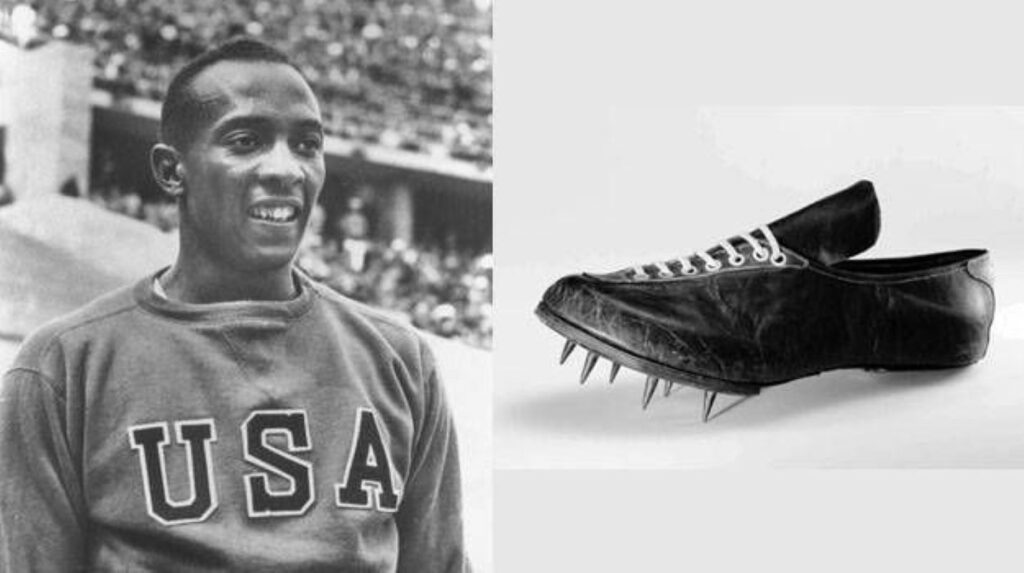
How World War II Made Them Turn Against Each Other
The name of the Dazzler Brothers spread throughout the world and the company quickly became popular. But when World War II broke out,the distance between the brothers widened. Both Rudolf and Adi were members of the Nazi Party. Their factory was even used to produce military equipment.While Rudolf directly joined the army for Hitler’s forces, Adi took charge of the company and stayed away from politics. Their relationship hit rock bottom during the war. Rudolf believed that Adi deliberately got him enlisted in the army to trap him. Resulting in Rudolf being imprisoned after the war. This destroyed whatever trust remained between them forever!

There’s another reason behind their strained relationship. During a bombing in 1943, It’s said that Adi insulted Rudolf’s family when they took shelter together. This incident caused an irreversible rift between the brothers. The incident is mentioned in the book Sneaker Wars by Barbara Smith and other sources, though its authenticity remains debated. After the war, as Germany lay defeated, their shoe factory was on the verge of destruction. Then Addie’s wife, Kathy Dazzler, used diplomatic skills to convince Allied military officials that the shoes they made were once worn by American athlete Jesse Owens, who won four gold medals at the Olympics. Hearing this story, the Allies decided not to destroy the factory.
Read More: Youth Self Employment Empowered with Tk100 Crore Budget Fund Plan
The New Beginning of Adidas and Puma
There is no doubt that the relationship between the two brothers had completely broken down, and as a result, their business relationship ended forever. After the war, the two brothers could no longer work together.The relationship had deteriorated so much that they didn’t even want to look at each other’s faces.Finally, in 1948, they separated.
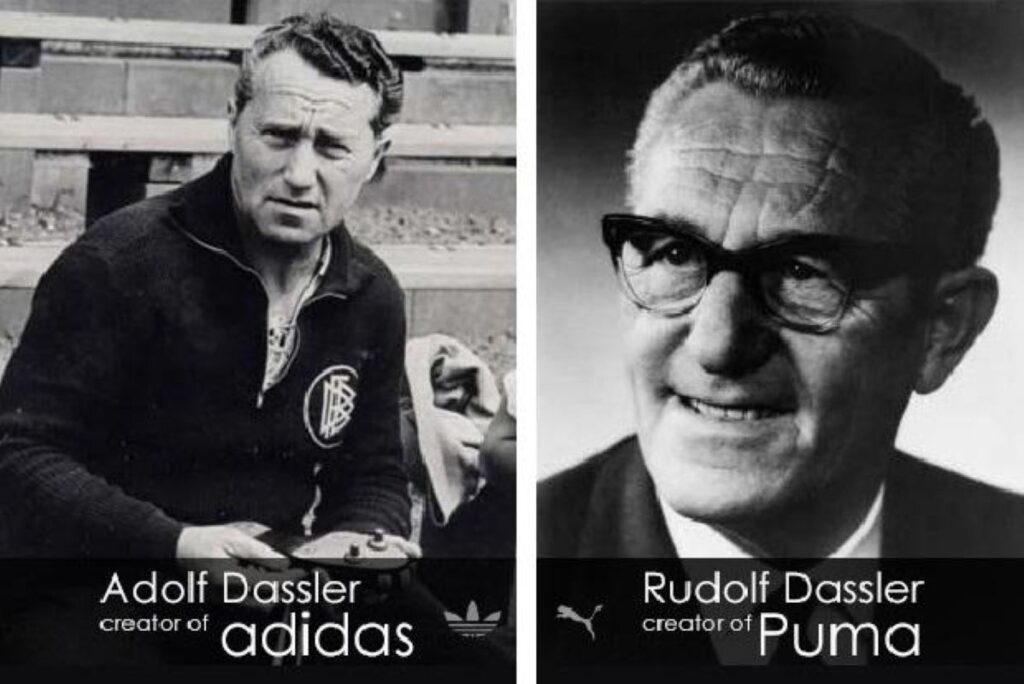
In 1949, Adi Dassler founded his new company and named it Adidas .A combination of his name “Adi” and “Das.” Rudolf initially named his new company Ruda but later changed it to Puma to reflect the agility of an African cheetah in athletic shoes. Now the rivalry has turned into a business war. They started competing through their brands.
How Shoes Divided a Town
The town of Herzogenaurach was once peaceful and united, like the Dazzler family.But the rivalry between the brothers divided the town completely! The city of Herzogenaurach was completely divided into two parts.People could tell who was a supporter of which company by looking at the shoes. Adidas employees lived on one side, and Puma employees lived on the other. Even shoe stores had to choose , would they sell Puma or Adidas? But they can never sell these two brands of shoes together. This was a real sin for that city. The town was so divided that people would first look at someone’s shoes before talking to them, giving the town the nickname “The Town of Bent Necks.”

Who Took the Lead?
Initially, Puma had the edge. Their Super Atom boot became very popular among footballers in 1952. But two years later, in 1954, West Germany won their first World Cup wearing Adidas boots! This was a massive success for Adidas. Before the 1970 World Cup, the two companies agreed that neither would sign a deal with legendary footballer Pelé. This agreement was called the “Pelé Pact.” This was an unwritten agreement between Adidas and Puma. But Puma broke the agreement.
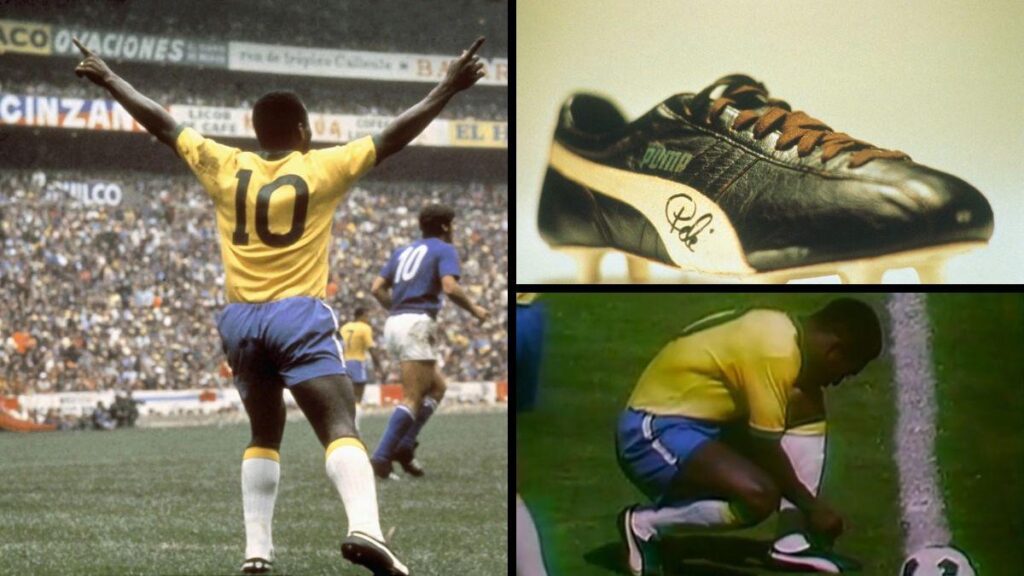
Instead of going directly into promotion, Puma’s brand and marketing team adopted a different strategy. They made a secret deal with Pelé. During the 1970 World Cup, just before the kickoff, Pelé knelt on the field to tie his shoelaces and the camera zoomed in on his shoes. And Puma’s name appeared in front of billions of viewers. The eyes of the whole world were on Pele’s feet! The cameras captured the scene, and the whole world learned Puma’s name! It was a brilliant marketing strategy which made the Puma brand popular overnight worldwide.
How the Rivalry Finally Ended
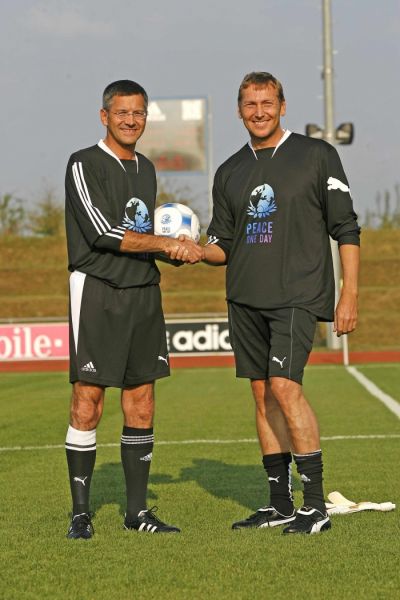
Meanwhile, the two brothers never forgot their conflict and never spoke to each other while they were alive. There was a time when they dreamed together,made shoes together. But their final destination is also in two opposite directions! After their deaths, they were buried in the same cemetery in Herzogenaurach, but in completely opposite directions! However, in 2009, Adidas and Puma employees forgot about their rivalry and organized a symbolic football match. This was the official end of the rivalry between the two brands.
Adidas: Identity, Innovation, and Global Reach
Adidas is known worldwide for its iconic 3-stripe design and groundbreaking sports technology. With major collaborations and a focus on performance, it has established itself as a leader in both athletic wear and fashion.

Brand Identity and the Iconic 3-Stripes
Adidas is one of the most well-known and respected names in the global sportswear market. It represents more than just athletic clothing—it stands for a culture of performance, innovation, and motivation. A key part of Adidas’s brand identity is the iconic 3-stripe design, originally introduced to give extra stability to shoes. Over the years, those three simple lines evolved into a globally recognized symbol of quality and strength. Today, they are not only a part of Adidas’s visual identity but also a statement of its athletic roots and fashionable appeal. Whether on the football field or the streets of a major city, the 3-stripe mark connects people to a lifestyle of ambition and energy.
Read More: UN Urges Nearly $1 Billion in Urgent Aid for Rohingya Refugees in Bangladesh
Technological Innovations
Adidas has always been at the front of innovation in sportswear. One of its earliest breakthroughs was the creation of football boots with interchangeable cleats, which allowed players to switch studs based on different playing surfaces. This was a revolutionary step at the time and gave Adidas a serious edge in professional football. Over the decades, the company continued to invest in research and development to improve athletic performance, creating lightweight materials, energy-return soles, and specialized gear for different sports. These innovations not only improved functionality but also helped athletes achieve better results, strengthening Adidas’s reputation as a leader in sports science.
Major Milestones
The journey of Adidas has been full of major achievements that helped shape its position in the global market. One such milestone was becoming the official sponsor of the German national football team, a partnership that brought global attention to the brand, especially during international tournaments. In 2006, Adidas expanded its empire by acquiring Reebok, another global sportswear brand. This strategic move helped Adidas increase its market share in North America and compete more directly with its biggest rival, Nike. These actions showed Adidas’s ambition to grow not just as a European brand, but as a true global powerhouse in sports and lifestyle.
Celebrity Collaborations and Cultural Influence
Beyond sports, Adidas has made a strong impact on pop culture and fashion through collaborations with global celebrities. The partnership with rapper and designer Kanye West for the Yeezy line brought Adidas to the center of sneaker culture, making it a must-have brand for streetwear enthusiasts. Similarly, partnerships with artists like Beyoncé (through Ivy Park) and Pharrell Williams helped the brand connect with younger audiences and communities focused on creativity and self-expression. These collaborations allowed Adidas to go beyond the gym or stadium and become a fashion statement worn by artists, influencers, and everyday fans around the world.
Slogan and Core Values
Adidas operates under the motivational slogan “Impossible is Nothing,” which perfectly reflects the brand’s mission to push boundaries and support people in achieving their dreams. This message is not just for elite athletes—it speaks to anyone striving to do better in life, sports, or any personal goal. The company’s core values—performance, innovation, and inspiration—are reflected in everything it produces, from high-tech running shoes to stylish casual wear. These values continue to guide Adidas as it navigates the future, blending tradition with modernity to stay ahead in the ever-evolving world of sportswear.
Puma: Style, Speed, and Cultural Fusion
Puma stands out for its dynamic blend of sports performance and urban style, symbolized by its iconic jumping cat logo. Known for collaborations with pop culture icons and top athletes, Puma appeals especially to younger, trend-conscious consumers worldwide.
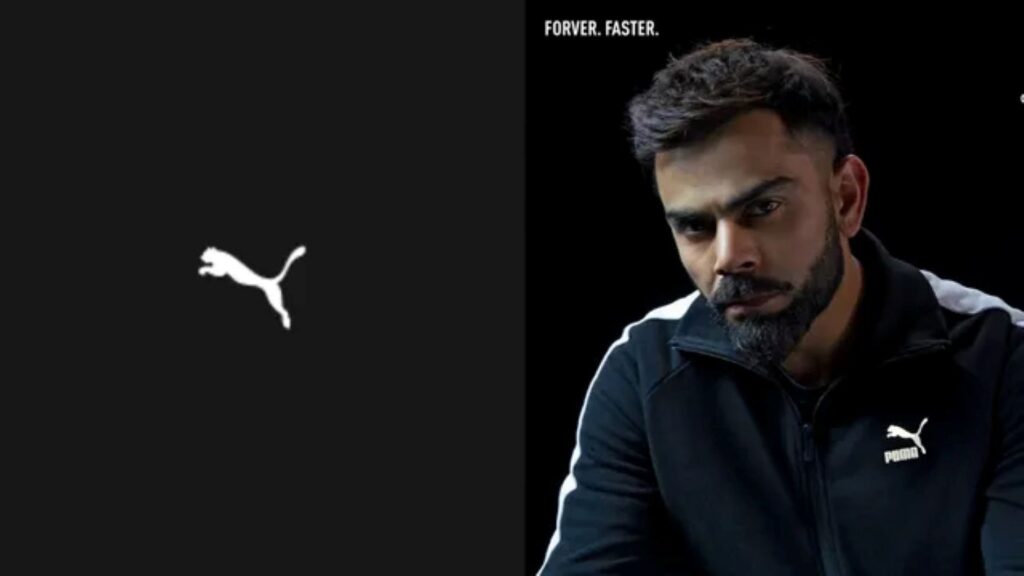
Brand Identity and the Jumping Cat Symbol
Puma is a global name in sportswear, instantly recognizable by its sleek and powerful jumping cat logo. This symbol represents agility, youth, and fearless energy qualities that define Puma’s brand identity. Unlike traditional sportswear brands that focus strictly on performance, Puma has always aimed to create a balance between athletic functionality and street style. It appeals strongly to a younger, trend-conscious audience that values both comfort and fashion. Puma’s branding leans into urban culture, vibrant designs, and an edgy attitude, making it stand out in a crowded market.
Legendary Athletes and Sports Moments
From the football fields of the 20th century to the Olympic tracks of the 21st, Puma has been associated with some of the most iconic athletes in history. The brand rose to fame when football legends like Pelé and Diego Maradona wore Puma boots during some of the most memorable matches ever played. In more recent times, Puma’s image of speed and excellence was strengthened through its partnership with Usain Bolt. Bolt’s lightning-fast performances while wearing Puma shoes helped reinforce the brand’s credibility and dominance in the world of athletics. These athlete endorsements weren’t just marketing—they were moments of global pride and visibility for Puma.
Cultural Collaborations and Pop Icons
One of Puma’s most innovative strategies has been its deep dive into the world of music, fashion, and pop culture. The brand made headlines when it teamed up with global superstar Rihanna, who not only became a brand ambassador but also led her own Fenty x Puma collection. This move brought high fashion to sportswear, creating bold designs that appealed to both the fashion-forward and everyday consumers. Puma has also collaborated with stars like Selena Gomez, The Weeknd, and BTS members, helping the brand connect with millions of young fans around the world. These collaborations gave Puma a unique edge—it wasn’t just a sports brand anymore; it became a fashion statement.
A Bridge Between Sport and Street
Puma excels at blending the boundaries between sport and lifestyle. Whether it’s on a basketball court, in a motorsport arena, or walking down the street, Puma’s gear is designed to be both functional and stylish. The brand’s collections often include bold color schemes, retro influences, and street-ready silhouettes that appeal to sneakerheads and athletes alike. This fusion allows Puma to be present in a wide range of subcultures, from breakdancing crews to urban youth movements. By staying versatile, Puma has built a strong and diverse community of loyal fans who wear its products with pride.
Fusion of Style, Speed, and Culture
With the slogan “Forever Faster,” Puma sends a clear message: it is always evolving, adapting, and pushing boundaries. The brand is not only about performance but also about identity, energy, and creativity. It aims to empower people—whether they’re athletes, musicians, or students—to move boldly and express who they are. In combining elements of speed, style, and cultural relevance, Puma has created a brand that is as much about movement as it is about meaning. This fusion gives Puma a unique position in the global market, making it more than just a competitor to Adidas—it is a force of its own.
Current Market Scenario (2023-2025)
The global sportswear industry has experienced notable shifts between 2023 and 2025, with Adidas, Puma, and Nike each navigating unique challenges and opportunities.
Adidas: Strong Financial Growth and Strategic Recovery
Adidas continues to dominate the global sportswear industry with impressive financial results year after year. In 2023, the company generated a remarkable €21.43 billion in revenue, which increased significantly to €23.68 billion in 2024. This steady growth reflects Adidas’s strong brand recognition worldwide and its commitment to innovation in both sports performance and lifestyle fashion. The company’s ability to consistently launch new products that combine technology and style has helped it maintain a competitive edge. Alongside its growing revenues, Adidas reported a net profit of €598 million in 2024, showing that the company is not only expanding but also managing its operations efficiently to maximize profitability.
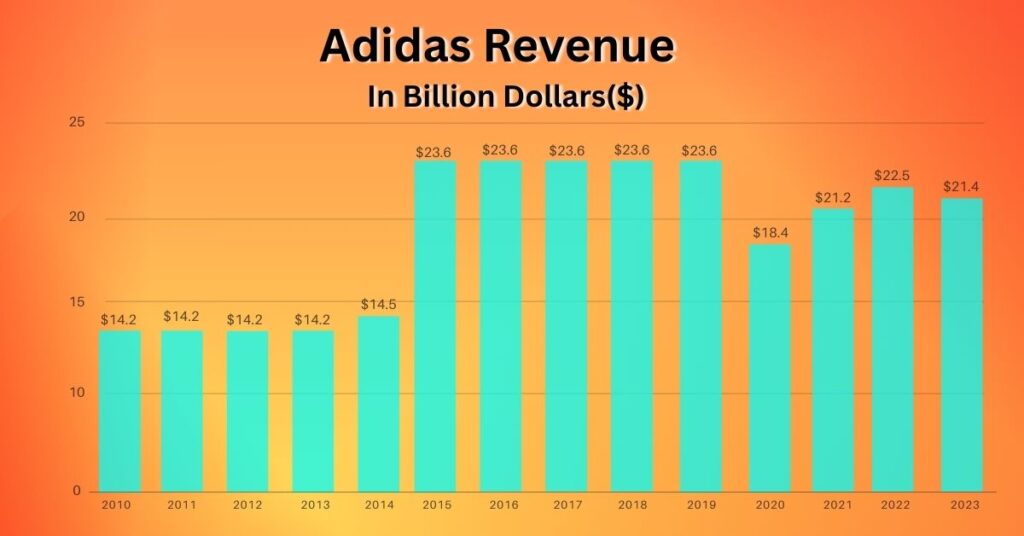
Puma: Steady but Smaller Market Presence
Though Puma operates on a smaller scale, it has demonstrated steady growth and has managed to carve out a unique space in the sportswear market. Puma’s revenue rose from €8.6 billion in 2023 to €8.82 billion in 2024, marking a 4.4% increase. This growth, while modest compared to Adidas, is significant given Puma’s more focused brand strategy targeting a younger, fashion-conscious audience. Puma is known for its comfortable and trendy designs that blend athletic wear with street style, making it especially popular among millennials and Gen Z consumers. However, despite its growing popularity, Puma’s net profit of €282 million in 2024 is less than half that of Adidas, highlighting the financial gap between the two brands.
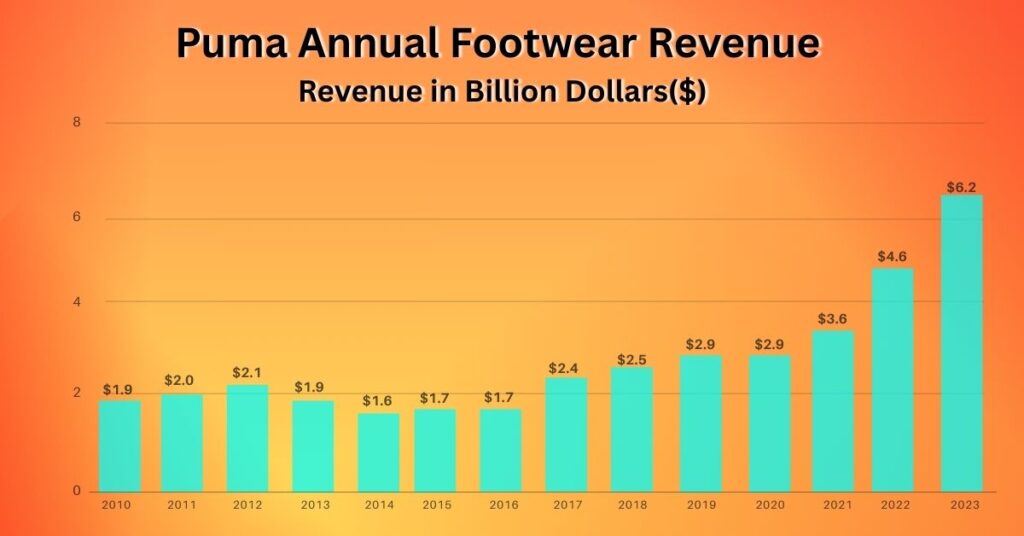
Nike: Dominant Market Leader
Despite their fierce rivalry, both Adidas and Puma are significantly smaller compared to the real dominator of the global sportswear industry—Nike. As of 2023, Nike controlled 18.2% of the worldwide sportswear market, far ahead of Adidas, which held 8%, and Puma, which accounted for only 2.6%. This wide gap shows that Nike remains the dominant player due to its strong global presence, successful marketing campaigns, and continuous innovation across multiple sports categories. For Adidas and Puma, the challenge is not just competing with each other, but also finding ways to close the large gap with Nike by appealing to changing consumer tastes and expanding into new markets.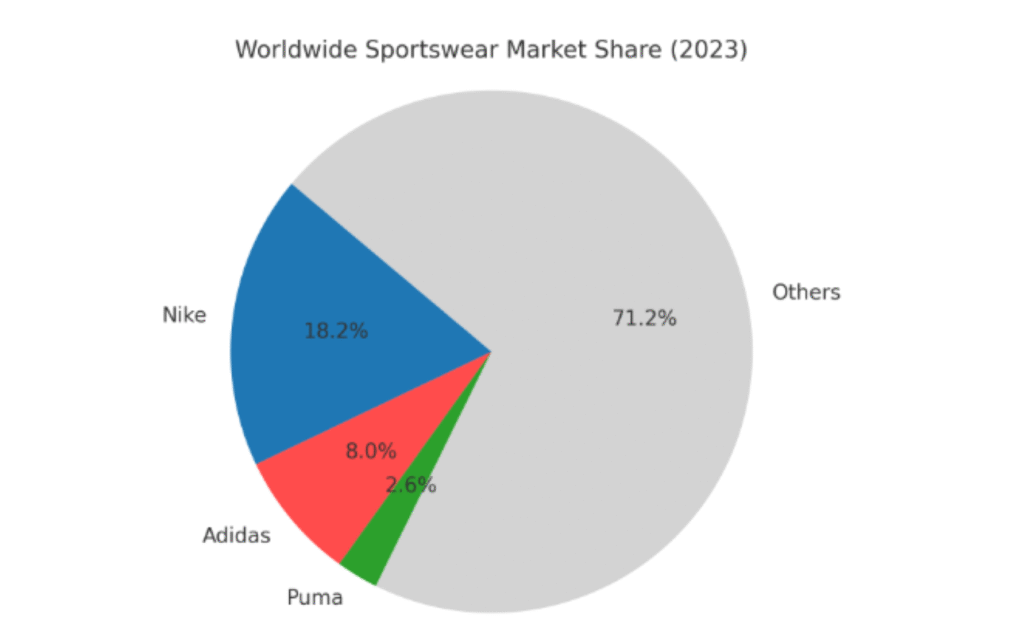
Bangladesh and Global Brands
Bangladesh is a developing country in the third world, where the younger generation is now embracing expensive global brands like Nike, Adidas, and Puma. However, for decades, the only trusted and reliable shoe brand for the masses has been Bata and Apex.
In Bangladesh, Bata and Apex stand out as the two most dominant and trusted footwear brands. Bata, a multinational company with a long-standing presence, is known for its wide accessibility, durability, and affordable pricing. It has served generations of Bangladeshi families and is often seen as the go-to brand for school shoes, office wear, and everyday use. On the other hand, Apex, a homegrown Bangladeshi brand, has rapidly risen in prominence by combining quality with fashion-forward designs. Apex appeals to the middle and upper-middle class with its stylish collections and strong retail presence across the country. Together, these two brands have shaped the country’s footwear landscape, Bata with its legacy of trust and Apex with its modern, trend-conscious approach.
How the Israel Conflict Could Affect Bata’s Revenue in Bangladesh
In 2024, Bata Shoe Company in Bangladesh faced a tough year, reporting a 26% drop in profit to Tk 296 million due to economic instability, political changeover, and severe floods. The company experienced reduced sales, especially in the third quarter, when losses reached Tk 128 million. Despite this, Bata declared a record 445% cash dividend for the year—its highest since 1985—drawing Tk 312 million from retained earnings. Analysts suggest this generous payout reflects improved foreign exchange conditions but may also signal fewer reinvestment opportunities. Bata’s total revenue for the first nine months stood at Tk 6.96 billion, down 8% year-on-year.
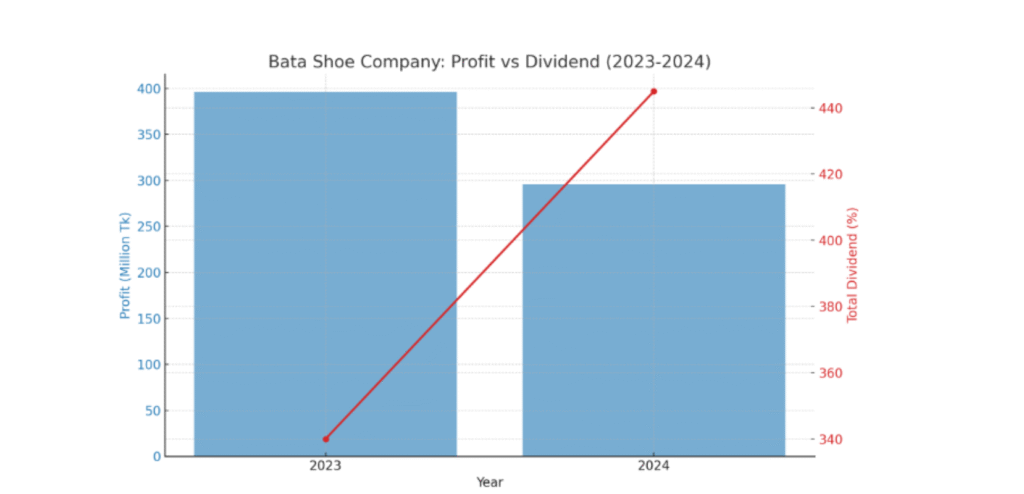
Apex Footwear makes record sales
Apex Footwear, one of Bangladesh’s leading shoemakers, experienced a mixed financial performance in fiscal year 2023–24. While the company faced challenges in the first half, it demonstrated resilience and growth in the latter part of the year. The graph illustrates Apex Footwear’s revenue performance over FY23, FY24, and the trailing twelve months (TTM). In FY23, the company achieved its highest recent revenue, but in FY24, revenue declined due to economic challenges, including inflation, political instability, and reduced consumer spending. However, the TTM figures show signs of gradual recovery, suggesting that Apex is stabilizing its operations and slowly regaining market momentum.
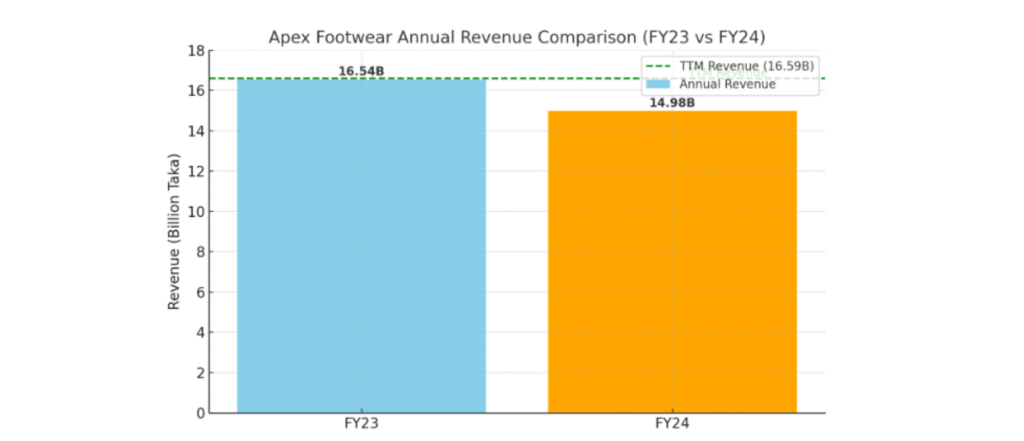
Lessons from a Family Feud
The intense rivalry between Adidas and Puma demonstrates how competition, even when rooted in personal family disputes, can become a powerful force for innovation and industry transformation. This story reveals that conflicts within families often extend beyond personal boundaries and deeply affect business operations, sometimes creating challenges that take years to resolve.
It underscores the critical need to clearly separate family relationships from professional roles to avoid damaging misunderstandings or divisions that can hinder growth and stability. Beyond being a cautionary tale, their feud is a compelling example of how vision, branding, and strategic competition can shape the trajectory of companies and drive them to extraordinary success, even when born from adversity. It teaches modern entrepreneurs the importance of turning challenges into opportunities and maintaining focus on long-term goals despite personal differences.
Conclusion
From what began as a bitter family quarrel in a small German town, Adidas and Puma evolved into two of the world’s most influential and recognizable sportswear brands. Their story is a testament to the transformative power of rivalry when combined with clear vision, innovation, and strategic marketing. Despite the personal conflicts that divided their founders, both companies harnessed their competitive spirit to push boundaries, innovate products, and capture global markets.
Their journey highlights that success does not necessarily come from harmony, but from the drive to excel, even in the face of adversity. Today, the legacy of Adidas and Puma serves as an inspiration to entrepreneurs, designers, and business leaders worldwide, reminding them that passion, perseverance, and the ability to overcome conflict are key ingredients for building lasting impact and global success.
References:
Share via:

